Sigh.
How many times have you been
You pause for a brief eye roll.
You might call out the poster, or move on with your day – slightly annoyed.
But what if that false report was about your industry, or even worse...your business?
Fake news can wreak havoc on companies and entire industries.
In this post, we’ll look at how can use your digital content strategy to protect your business against the harms of fake news. On top of that, we’ll discuss a few ways you can use fake news as a communication and PR opportunity.
Fake news is old news
I spent some time researching the origins of fake news and discovered it’s been around for a long time. ( Here’s the full article I wrote if you’d like to learn more.)
So, what’s new about false reports in the 21st century?
Social media.
The digital revolution spurs the spread of lies and misinformation and increasingly brands are caught in the crosshairs.
The Rise of Fake News
In 2016, Facebook released a new format for updates: text on a
Fast forward to 2019, and Poynter reports false text posts – using this format – are being “weapoinzed”
Google Trends reveals interest in the term (relative to other queries) is climbing.
And brands who find themselves in the eye of the storm pay dearly.
Shortly after the U.S elections in 2016, former Pepsi CEO Indra Nooyi was misquoted as saying Trump supporters should take their business elsewhere.
It didn’t matter that Nooyi never said it, the quote went viral. The reverberations were felt on social media and the stock market.
Trump supporters called for a boycott on Pepsi products. Sentiment scores for the product dropped sharply, and the share price plummeted, according to this analysis from Alva.
But, Pepsi is a massive global company and you might think that false news or misinformation isn’t a concern for your small or medium business.
The thing is even if you’re not directly a target, as a modern business, you can gain from including a plan to deal with fake news in your digital content strategy.
Use your Brand Expertise to Kill Fake News
Your unique brand voice is something special.
In this blog post, we looked at the power of owning your expertise. I mentioned a CopyBlogger podcast where digital strategist Ronell Smith discussed the value of “specificity”.
Smith’s position is simple: your deep industry expertise in your niche is your competitive edge.
This means when a new report comes out with information that’s either distorted or plain untrue, you’re in a strong position to communicate the facts to your customers, industry bodies and journalists.
An easy way to do this is to answer the most common questions. Clear up the confusion. Lay the facts out simply and succintly.
I remember managing crisis communications for a regional government unit during a severe animal disease outbreak. Working with my colleagues to get expert information, I issued a FAQ far and wide to clear up the common questions. The message quickly gained traction and soon reporters – and the public – were well versed on misconceptions and truths.
Include (Trusted) Third-Party Sources
Seeing is believing. Except on the internet.
Isn’t it hard to trust anything you read online, nowadays?
So, when you want to address a fake news report or bring clarity to a murky industry issue, add credibility with third-party stats and quotes. (This is a good practice to keep in mind for your digital content strategy in general.)
This draws on the idea of taking a newsroom approach to your content creation.
Another solid concept to consider for your digital content strategy is to give details instead of vague marketing speak. In a post on writing marketing copy that sells, Henneke Duistermaat urges us to “show not tell”.
If your apply this to your business blog, instead of saying the new regulation is good for consumers, your analysis might report:
“Under the new law, consumers will have access to a greater number of providers and corporates will have to release details around their pricing strategies.”
Ban Fake News From Your Digital Content Strategy
This might sound obvious, but how many times have you shared a post after only reading the headline…at least once? (Guilty!)
Like you, I’ve learned to be more vigilant; however; many of us still don’t read articles and vet them before we share. And this makes it easier to spread fake news.
When brands do this, it affects the bottom line.
Fifty-nine percent of consumers would stop purchasing from a brand if they shared fake news, according to a survey from Hill Holiday.
Always make sure you’re sharing from a reputable news or industry source. Some fake news websites masquerade as real news sites, but you may notice the domain is slightly different.
If you’re still not sure, do an online search, reference fact checking sites like Snopes.com and check with your contacts.
Stay Connected with Social to act Quickly
Brands
But don’t worry – you don’t need a big budget to go full Olivia Pope.
The following tools can alert you to mentions of your brand – or industry- online:
Both Talkwalker and Hootsuite have free plans, while Mention’s entry level plan starts at $25 monthly.
The internet presents an opportunity to connect with your customers in new ways, but also gives rise to brand risks like fake news. Considering – and planning for – threats online keeps your digital content strategy relevant and useful.
